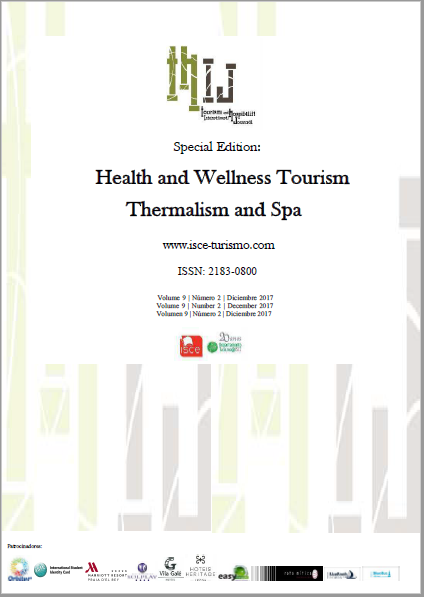Thermal spa treatments and benefits perceived by users of Cró and Carvalhal spa for dermatological purpose
DOI:
https://doi.org/10.57883/thij9(2)2017.30472Palabras clave:
Agua Termal, Balneario de Cró, Balneario de Carvalhal, Dermatología, Turismo de Salud, Tratamiento TermalResumen
Thermalism constitutes one touristic product highly recognized for its enormous potential regarding the exploitation of regional endogenous resources with noteworthy economic impacts for local communities. In the last decades, an important change occurs in the clinical use of thermal water for the treatment of several dermatological diseases, mainly due to the increase of knowledge and research, that highlighting the beneficial effects of these waters to support, improve or treatment of different disorders.The aim of present study was the evaluation of the benefits of thermal treatments on different skin diseases perceived by users (N=74) with dermatological diseases, of the thermal spas of Cró and Carvalhal, from the central region of Portugal. Most of the participants claim to have knowledge of the dermatological therapeutic benefits/properties of the thermal waters (78.4%), highlighting the healing effect, moisturizing and anti-itching properties. Although a small number of participants meet some secondary effects (25.7%), tiredness and drowsiness were the more often referred. The thermal treatment most frequently used were immersion bath (49.3%), partial/general shower-massage (17.8%), thermal swimming-pool (15.8%) and circular shower (8.2%). Reduction of erythema (27.8%), flaking (25.6%) and pruritus (25.6%) were the most valuated improvements on skin conditions referred by participants.It was concluded that thermal spas users claim to have knowledge about the effectiveness and safety of thermal waters in skin pathologies treatment. Therefore, it is envisioned that growing well-being modality of thermalism together with the medicinal one, it will certainly be rendered in a high economic impact in this touristic market.
Citas
(DGEG), D. G. d. E. e. G. (2015). Estatisticas Águas - Distribuição de aquistas por grupos etários em 2015.
Antunes, J. (2012). O (re) posicionamento do termalismo como estratégia de desenvolvimento turístico. O caso da região Dão-Lafões (NUTS III). Revista Turismo & Desenvolvimento, 3(17/18), 1469-1480.
Araujo, A., Sarraguça, M., Ribeiro, M., & Coutinho, P. (2016). Physicochemical fingerprinting of thermal waters of Beira Interior region of Portugal. Environmental geochemistry and health, 1-14.
Araujo, A. R., Paiva, T., Ribeiro, M. P., & Coutinho, P. (2015). Innovation in Thermalism: An Example in Beira Interior Region of Portugal Health and Wellness Tourism (pp. 165-180): Springer.
Chevutschi, A., Dengremont, B., Lensel, G., Pardessus, V., & Thevenon, A. (2007). La balnéothérapie au sein de la littérature: Applications thérapeutiques. Kinesitherapie, la revue, 7(71), 14-23.
Costa, C., Quintela, J., & Mendes, J. (2015). Health and wellness tourism: a strategic plan for tourism and thermalism valorization of São Pedro do Sul (ss. 21-31). Marta Peris-Ortiz ve José Álvarez-García. Health and Wellness Tourism Emergence of a New Market Segment.
Faílde, R. M., & Mosqueira, L. M. (2006). Afecciones dermatológicas y cosmética dermotermal. Técnicas y Tecnologías en Hidrología Médica e Hidroterapia, 175-179.
García, J. Á., del Río, M. d. l. C., González-Vázquez, E., & Lindahl, J. M. M. (2015). Motivations for implementing a system of quality management in Spanish thalassotherapy centers Health and wellness tourism (pp. 101-115): Springer.
García, J. Á., Del Río, M. d. l. C., Rama, J. A. F. B., & Alonso, M. V. (2014). Nivel de implementación de la calidad en los balnearios españoles. PASOS. Revista de Turismo y Patrimonio Cultural, 12(2), 259-280.
Ghersetich, I., Freedman, D., & Lotti, T. (2000). Balneology today. Journal of the European Academy of Dermatology and Venereology, 14(5), 346-348.
Halevy, S., & Sukenik, S. (1998). Different modalities of spa therapy for skin diseases at the Dead Sea area. Archives of dermatology, 134(11), 1416-1420.
Lopes, R. P. (2016). Motivações e Práticas dos aquistas das Termas de Unhais da Serra.
Lotti, T. M., & Ghersetich, I. (1996). Mineral waters: Instead of soap or better than soap? Clinics in dermatology, 14(1), 101-104.
Matz, H., Orion, E., & Wolf, R. (2003). Balneotherapy in dermatology. Dermatologic therapy, 16(2), 132-140.
Merial-Kieny, C., Mengual, X., Guerrero, D., & Sibaud, V. (2011). Clinical efficacy of Avene hydrotherapy measured in a large cohort of more than 10,000 atopic or psoriatic patients. Journal of the European Academy of Dermatology and Venereology, 25(s1), 30-34.
Nunes, S., & Tamura, B. M. (2012). Revisão histórica das águas termais. Surgical & Cosmetic Dermatology, 4(3), 252-258.
Panico, V., & Imperato, R. (2009). The psoriasis: a therapeutic alternative with sulphureous water of Terme Capasso. Journal of Water & Wellness, 1(1), 39-50.
Portugal, T. d. (2015). Termas em Portugal 2014 - Caracterização da oferta e da procura.
Tabolli, S., Calza, A., Di Pietro, C., Sampogna, F., & Abeni, D. (2009). Quality of Life of Psoriasis Patients before and after Balneo-or Balneophototherapy. Yonsei medical journal, 50(2), 215-221.
Torres, A., Bacaicoa, J., Horno, M., Galán, I., Failde, R., Hernansanz, A., & GIMÉNEZ, J. (2006). Técnicas e tecnologias en hidrologia médica e hidroterapia. Madrid: Agencia de Evaluación de Tecnologías Sanitarias, 15-43.
Descargas
Publicado
Cómo citar
Número
Sección
Licencia
Derechos de autor 2023 This work is licensed under a Creative Commons - Attribution 4.0 International (CC BY 4.0)

Esta obra está bajo una licencia internacional Creative Commons Atribución 4.0.
Este trabalho encontra-se publicado com a Licença Internacional Creative Commons Atribuição 4.0.






